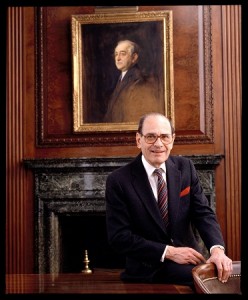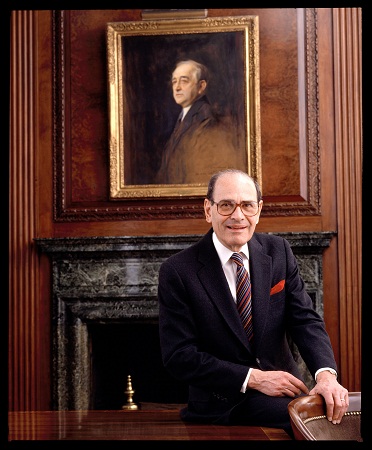
NEW YORK—Former New York Times publisher Arthur Ochs Sulzberger, who led the newspaper to new levels of influence and profit while standing up for press freedom and editorial independence during some of the most significant moments in 20th-century journalism, died Saturday. He was 86.
Sulzberger, who went by the nickname “Punch” and served with the Marine Corps before joining the Times staff, first as a reporter, and then following his father and grandfather as publisher, died at his home in Southampton, New York, after a long illness, his family announced.
During his three-decade tenure, the newspaper won 31 Pulitzer prizes, published the Pentagon Papers on U.S. involvement in the Vietnam War, and won a libel case victory in New York Times vs. Sullivan that established important First Amendment protections for the press. The First Amendment of the U.S. Constitution guarantees freedom of the press and other basic rights.
“Punch, the old Marine captain who never backed down from a fight, was an absolutely fierce defender of the freedom of the press,” his son, and current Times publisher, Arthur Ochs Sulzberger Jr., said in a statement. He said his father’s refusal to back down in the paper’s free-speech battles “helped to expand access to critical information and to prevent government censorship and intimidation.”
In an era of declining newspaper readership, the Times’ weekday circulation climbed from 714,000 when Sulzberger became publisher in 1963 to 1.1 million upon his retirement as publisher in 1992. Over the same period, the annual revenues of the Times’ corporate parent rose from $100 million to $1.7 billion.
“Above all, he took the quality of the product up to an entirely new level,” the late Katharine Graham, chairwoman of The Washington Post Co., said at the time Sulzberger relinquished the publisher’s title.
Sulzberger was the only grandson of Adolph S. Ochs (pronounced ox), the son of Bavarian immigrants who took over the Times in 1896 and built it into the most influential newspaper in the U.S.
The family retains control to this day, holding a special class of shares that give them more powerful voting rights than other stockholders.
Power was thrust on Sulzberger at the age of 37 after the sudden death of his brother-in-law in 1963. He had been in the Times executive suite for eight years in a role he later described as “vice president in charge of nothing.”
But Sulzberger directed the Times’ evolution from an encyclopedic paper of record to a more reader-friendly product that reached into the New York City suburbs and across the U.S.
During his tenure, the Times started a national edition, bought its first color presses, and introduced popular as well as lucrative new sections covering topics such as science, food and entertainment.
“If you weren’t around then, you forget the unbelievable outrage that greeted those sections. But in retrospect it was the right decision both editorially and economically,” said Nicholas Lemann, dean of the Columbia University Graduate School of Journalism.
A key figure in the transformation was A.M. Rosenthal, executive editor from 1977 to 1986. Rosenthal, who died in 2006, called Sulzberger “probably the best publisher in modern American history.”
Sulzberger also improved the paper’s bottom line, pulling it and its parent company out of a tailspin in the mid-1970s and lifting both to unprecedented profitability a decade later.
In 1992, Sulzberger relinquished the publisher’s job to his 40-year-old son, Arthur Ochs Sulzberger Jr., but remained chairman of The New York Times Co. Sulzberger retired as chairman and chief executive of the company in 1997. His son then was named chairman. Sulzberger stayed on the Times Co. board of directors until 2002.
Reacting to news of Sulzberger’s death Saturday, former Times executive editor Joseph Lelyveld said that his business success was matched by integrity in the newsroom.
“As an editor, you knew that if you went to the publisher and sought his support on an issue that you deemed to be of high importance, you could pretty much count on getting it. He knew how to back his people,” Lelyveld said. “The last years have been extremely difficult with his health problems. He bore them with great courage. I admired him hugely.”
President Barack Obama said Sulzberger was “a firm believer in the importance of a free and independent press — one that isn’t afraid to seek the truth, hold those in power accountable, and tell the stories that need to be told.”
New York Gov. Andrew Cuomo said Sulzberger “changed the course of American history with his journalistic decisions.”
Significant free-press and free-speech precedents were established during Sulzberger’s years as publisher, most notably the Times vs. Sullivan case. It resulted in a landmark 1964 Supreme Court ruling that shielded the press from libel lawsuits by public officials unless they could prove actual malice.
In 1971, the Times led the First Amendment fight to keep the government from suppressing the Pentagon Papers, a series of classified reports on the Vietnam War. Asked by a reporter who at the Times made the decision to publish the papers, Sulzberger gestured toward his chest and silently mouthed, “me.”
Sulzberger read the more than 7,000 pages of the Pentagon Papers before deciding to publish them. After Sulzberger read the papers, he was asked what he thought. “Oh, I would think about 20 years to life,” he responded.
But in a landmark decision, the U.S. Supreme Court eventually sided with the Times and The Washington Post, which had begun publishing the papers a few days after the Times.
“Punch Sulzberger was a giant in the industry, a leader who fought to preserve the vital role of a free press in society and championed journalism executed at the highest level,” said Associated Press President and CEO Gary Pruitt. “The Associated Press benefited from his wisdom, both during his years on the board of directors and his thoughtful engagement in the years that followed.”
Gay Talese, who worked at the Times as a reporter when Sulzberger took over and chronicled the paper’s history in his book “The Kingdom and the Power,” called him “a brilliant publisher. He far exceeded the achievements of his father in both making the paper better and more profitable at a time when papers are not as good as they used to be.”
In their book “The Trust,” a history of the Ochs-Sulzberger family and its stewardship of the paper, Susan E. Tifft and Alex S. Jones cited Sulzberger’s “common sense and unerring instincts.”
In an interview in 1990 with New York magazine, Sulzberger was typically candid about the paper’s readership.
“We’re not New York’s hometown newspaper,” he said. “We’re read on Park Avenue, but we don’t do well in Chinatown or the east Bronx. We have to approach journalism differently than, say, the Sarasota Herald Tribune, where you try to blanket the community.”
New York City’s mayor from 1978 to 1989, Ed Koch, said Sulzberger also had great humility, despite his extraordinary influence.
“With enormous power and authority he was as humble a person as you could ever meet,” Koch said Saturday. “People with enormous power often dominate a room. He did not. And yet the power and authority was there.”
In the mid-1980s, Sulzberger authorized the building of a $450 million color printing and distribution plant across the Hudson River in Edison, New Jersey, part of a plan to get all printing out of cramped facilities in the Times building in midtown Manhattan.
Sulzberger was born in New York City on Feb. 5, 1926, the only son of Arthur Hays Sulzberger and his wife, Iphigene Ochs Sulzberger, Adolph’s only child. One of his three sisters was named Judy, and from early on he was known as “Punch,” from the puppet characters Punch and Judy.
Sulzberger’s grandfather led the paper until his death in 1935, when he was followed by Sulzberger’s father, who remained at the helm until he retired in 1961.
Meanwhile, Arthur served in the Marines during World War II and, briefly, in Korea. He later observed, in a typically self-deprecating remark, that “My family didn’t worry about me for a minute. They knew that if I got shot in the head it wouldn’t do any harm.”
Except for a year at The Milwaukee Journal, 1953-54, the younger Sulzberger spent his entire career at the family paper. He joined after graduating from Columbia College in 1951. He worked in European bureaus for a time and was back in New York by 1955, but found he had little to do.
Sulzberger had not been expected to assume power at the paper for years. His father passed control to Orvil E. Dryfoos, his oldest daughter’s husband, in 1961. But two years later Dryfoos died suddenly of heart disease at 50. Punch Sulzberger’s parents named him publisher, the fourth family member to hold the title.
“We had all hoped that Punch would have many years more training before having to take over,” said his mother, Iphigene. Sulzberger relied on senior editors and managers for advice, and quickly developed a reputation as a solid leader.
At various times, Sulzberger was a director or chairman of the Newspaper Advertising Bureau, American Newspaper Publishers Association and American Press Institute. He was a director of The Associated Press from 1975 to 1984.
Sulzberger married Barbara Grant in 1948, and the couple had two children, Arthur Jr. and Karen. After a divorce in 1956, Sulzberger married Carol Fox. The couple had a daughter, Cynthia, and Sulzberger adopted Fox’s daughter from a previous marriage, Cathy.
Carol Sulzberger died in 1995. The following year, Sulzberger married Allison Cowles, the widow of William H. Cowles 3rd, who was the president and publisher of The Spokesman-Review and Spokane Chronicle of Spokane, Washington state. She died in 2010.











































